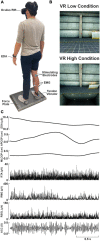Visual feedback-dependent modulation of arousal, postural control, and muscle stretch reflexes assessed in real and virtual environments
- PMID: 37082148
- PMCID: PMC10110857
- DOI: 10.3389/fnhum.2023.1128548
Visual feedback-dependent modulation of arousal, postural control, and muscle stretch reflexes assessed in real and virtual environments
Abstract
Introduction: The mechanisms regulating neuromuscular control of standing balance can be influenced by visual sensory feedback and arousal. Virtual reality (VR) is a cutting-edge tool for probing the neural control of balance and its dependence on visual feedback, but whether VR induces neuromodulation akin to that seen in real environments (eyes open vs. closed or ground level vs. height platform) remains unclear.
Methods: Here we monitored 20 healthy young adults (mean age 23.3 ± 3.2 years; 10 females) during four conditions of quiet standing. Two real world conditions (eyes open and eyes closed; REO and REC) preceded two eyes-open virtual 'low' (ground level; VRL) and 'high' (14 m height platform; VRH) conditions. We measured arousal via electrodermal activity and psychosocial questionnaires rating perceived fear and anxiety. We recorded surface electromyography over the right soleus, medial gastrocnemius, and tibialis anterior, and performed force plate posturography. As a proxy for modulations in neural control, we assessed lower limb reflexive muscle responses evoked by tendon vibration and electrical stimulation.
Results: Physiological and perceptual indicators of fear and anxiety increased in the VRH condition. Background soleus muscle activation was not different across conditions; however, significant increases in muscle activity were observed for medial gastrocnemius and tibialis anterior in VRH relative to REO. The mean power frequency of postural sway also increased in the VRH condition relative to REO. Finally, with a fixed stimulus level across conditions, mechanically evoked reflexes remained constant, while H-reflex amplitudes decreased in strength within virtual reality.
Discussion: Notably, H-reflexes were lower in the VRL condition than REO, suggesting that these ostensibly similar visual environments produce different states of reflexive balance control. In summary, we provide novel evidence that VR can be used to modulate upright postural control, but caution that standing balance in analogous real and virtual environments may involve different neural control states.
Keywords: H-reflexes; electrodermal activity; electromyography; muscle stretch reflexes; postural sway; tendon vibration; virtual reality.
Copyright © 2023 Hodgson, King, Darici, Dalton, Cleworth, Cluff and Peters.
Conflict of interest statement
The authors declare that the research was conducted in the absence of any commercial or financial relationships that could be construed as a potential conflict of interest.
Figures





Similar articles
-
Increased human stretch reflex dynamic sensitivity with height-induced postural threat.J Physiol. 2018 Nov;596(21):5251-5265. doi: 10.1113/JP276459. Epub 2018 Oct 9. J Physiol. 2018. PMID: 30176053 Free PMC article.
-
Both standing and postural threat decrease Achilles' tendon reflex inhibition from tendon electrical stimulation.J Physiol. 2017 Jul 1;595(13):4493-4506. doi: 10.1113/JP273935. Epub 2017 May 4. J Physiol. 2017. PMID: 28326567 Free PMC article.
-
Is lower leg proprioception essential for triggering human automatic postural responses?Exp Brain Res. 2000 Feb;130(3):375-91. doi: 10.1007/s002219900259. Exp Brain Res. 2000. PMID: 10706436
-
Contributions to the understanding of gait control.Dan Med J. 2014 Apr;61(4):B4823. Dan Med J. 2014. PMID: 24814597 Review.
-
Differential effects of low-frequency depression, vibration-induced inhibition, and posttetanic potentiation on H-reflexes and tendon jerks in the human soleus muscle.J Neurophysiol. 1986 Mar;55(3):551-68. doi: 10.1152/jn.1986.55.3.551. J Neurophysiol. 1986. PMID: 3514814 Review.
Cited by
-
Emotional state as a modulator of autonomic and somatic nervous system activity in postural control: a review.Front Neurol. 2023 Aug 31;14:1188799. doi: 10.3389/fneur.2023.1188799. eCollection 2023. Front Neurol. 2023. PMID: 37719760 Free PMC article. Review.
-
Upper limb muscle reflexes in real and virtual environments: Insights into sensorimotor adaptations.PLoS One. 2025 Aug 13;20(8):e0330129. doi: 10.1371/journal.pone.0330129. eCollection 2025. PLoS One. 2025. PMID: 40802681 Free PMC article.
-
The Role of Virtual Reality in Postural Rehabilitation for Patients with Parkinson's Disease: A Scoping Review.Brain Sci. 2024 Dec 29;15(1):23. doi: 10.3390/brainsci15010023. Brain Sci. 2024. PMID: 39851391 Free PMC article. Review.
-
The effects of periodic and noisy tendon vibration on a kinesthetic targeting task.Exp Brain Res. 2024 Jan;242(1):59-66. doi: 10.1007/s00221-023-06727-1. Epub 2023 Nov 13. Exp Brain Res. 2024. PMID: 37955706
References
-
- Albakri G., Bouaziz R., Alharthi W., Kammoun S., Al-Sarem M., Saeed F., et al. (2022). Phobia exposure therapy using virtual and augmented reality: a systematic review. Appl. Sci. 12:1672. 10.3390/app12031672 - DOI
LinkOut - more resources
Full Text Sources
Research Materials

